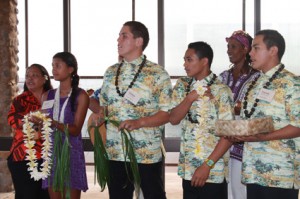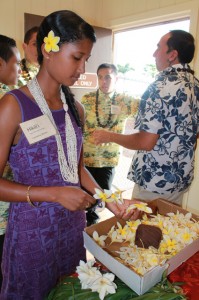How to Say E Komo Mai
While it is pau hana time for most teachers, Kumu Manuwai Peters and a few of his students are at Ho`olehua Airport getting ready for a busy afternoon. Holding an ukulele in one hand, Peters straightens a student’s kukui lei, all the while reminding the four student-volunteers to be professional, smile and engage visitors coming off the plane. By the time the next plane touches down, Peters and his band of students are already at the arrival gate, instruments, lei and smiles ready. As soon as the door opens, the group breaks into a traditional Hawaiian mele, or song, welcoming visitors and residents to Molokai.
The airport greeting program, called Kahau Pae `Ike, started last month as a partnership between Molokai High School (MHS) students, the Molokai Visitors Association and the State Department of Transportation Airports Division. Essentially, a group of three to five students from two of Peters’ classes –Hawaiian language and Arts and Communication –volunteer to gather at the airport on Tuesday and Thursday afternoons to greet people as they come off the plane.

MHS students Hikili`i Chow, Iokepa Albino, Hiwa Aea and Kainalu Dudoit greet airport visitors Thursday afternoon. Photo by Laura Pilz.
“I want people to see there’s a really vibrant population on Molokai that cares about our traditions and to maintain the tradition of welcome,” said Peters. “And [I want them to see] that Molokai youth show great promise.”
One of Kahau Pae `Ike’s visions is to prepare students for jobs at a professional level, and to ensure they are “effective 21st century communicators,” according to Peters. He makes sure each of his student-volunteers arrives prepared, dressed neatly in uniform and ready to work. As preparation, he makes sure the students are versed in greeting phrases in over 20 world languages, including Japanese, Spanish, Italian, Tahitian, Maori and Hawaiian.
“I’ve learned how to act when I’m on the job or when I’m talking to other people,” said MHS student Hikili`i Chow, 15, who has been greeting airport guests since the start of the program. “People are glad that opio –young people – are coming out to do it…[we] actually care about our island and set a good example for other generations.”

MHS student volunteer Hikili`i Chow strings together a plumeria lei. Photo by Laura Pilz.
Peters said he hopes to see the program continue and grow its presence at the airport. As of now, all the flowers and fruits are picked from the high school or donated by the community, and all efforts are volunteered. He hopes to be able to secure funds from the county to help grow the program, he said.
Till then, you may find Peters and a small group of students with ukes and lei in hand, greeting new and old friends with song, dance and smiles.











This is an excellent idea and both Kumu Manuwai and his participating students deserve special praise and thanks for showing this initiative, since it is an excellent example of drawing people together rather than dividing them (as is often the case on our island, regarding contentious issues). Everyone gains from this application of traditional aloha spirit…both those who are being greeted and those who are welcoming them. For those returning home, it is heart-warming evidence of being welcomed back to the greater kauhale that is Molokai. For those who are visiting for the first time, it is refreshing evidence that they are not merely despised ‘tourists’, but valued visitors and welcomed guests.
It is too easy to settle back into the mildly antagonistic ‘us and them’ pattern that has occasionally characterised the relationship between some kanaka maoli (and kama’aina, as well) and FOJ malihinis in the past. Sometimes it takes a positive inspiration (in this case, in the person of Kumu Manuwai) to step beyond those recidivist patterns of reflexive behavior and bridge them by demonstrating the need for living aloha in regular, daily life. And no, no one is saying that islanders must step back and allow outsiders (in the case of first time visitors) to intrude with unchecked displays of thoughtlessness and insensitivity, but here is a chance to say to them at the onset: “We welcome you to be our honored guests (with an unspoken but implied:…and invite you to respond reciprocally!)” If they’re smart enough, they’ll catch the charm and get the message without further proactive ‘culture buffering’ needed.
I’ll never forget my very first visit to Molokai, many years ago. I arrived wide-eyed on the inter-island puddle-jumper and was greeted by a fish-eyed customs agent who ignored my ‘aloha’ and looked at me like I had just stepped in something unpleasant. Shrugging that off and going up to the rental-car booth, I ran into a frothing haole (apparently kama’aina) who visibly fumed, his short fuse apparently aflame. I couldn’t even get out a ‘hello’ before he was off on a bitter rant about his troubles getting his East End hale built. Things went downhill from there, sadly, up to and including an encounter with a Molokai Public Library librarian (a kanaka wahine) who was deliberately and disdainfully rude for no reason (other than the fact that I was clearly FOJ haole and obviously not familiar at all with the island). All in all, it was a very sad experience, but one that I managed to instantly get past in the second or two it took for a pleasantly smiling kupuna on Ala Moana Street to say those magic words of welcome: “E como mai!” That remains as my lasting impression of Molokai nui a Hina!
Mahalos to Manuwai and the students of Molokai High! You da kine, eh! Auwe!
Kalikiano-I am glad you posted honestly about your experiences. I have been watching the island vibe for a while now and have often noticed the “negative” you spoke of. I am considering retiring on Molokai and have had second thoughts a few times due to this. I do not say this to be critical, just to bring awareness of how the island may be perceived by those of us eye balling it. I am aware of the hurts that the island has endured with the ranch and other big business. I pray that the natives can find in their hearts to remember that tourists are not big business. Most are bringing much needed money to the economy and are looking for the beauty and love that the island and it’s people possess. I am very aware of the “spirit” as lived on Oahu as a child. The love of the people and the island is what makes me want to return home. I don’t know what all is needed for healing, but the project highlighted in this article is a lovely start.
this is wonderful! mahalo!